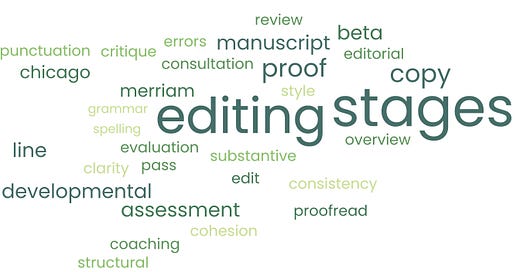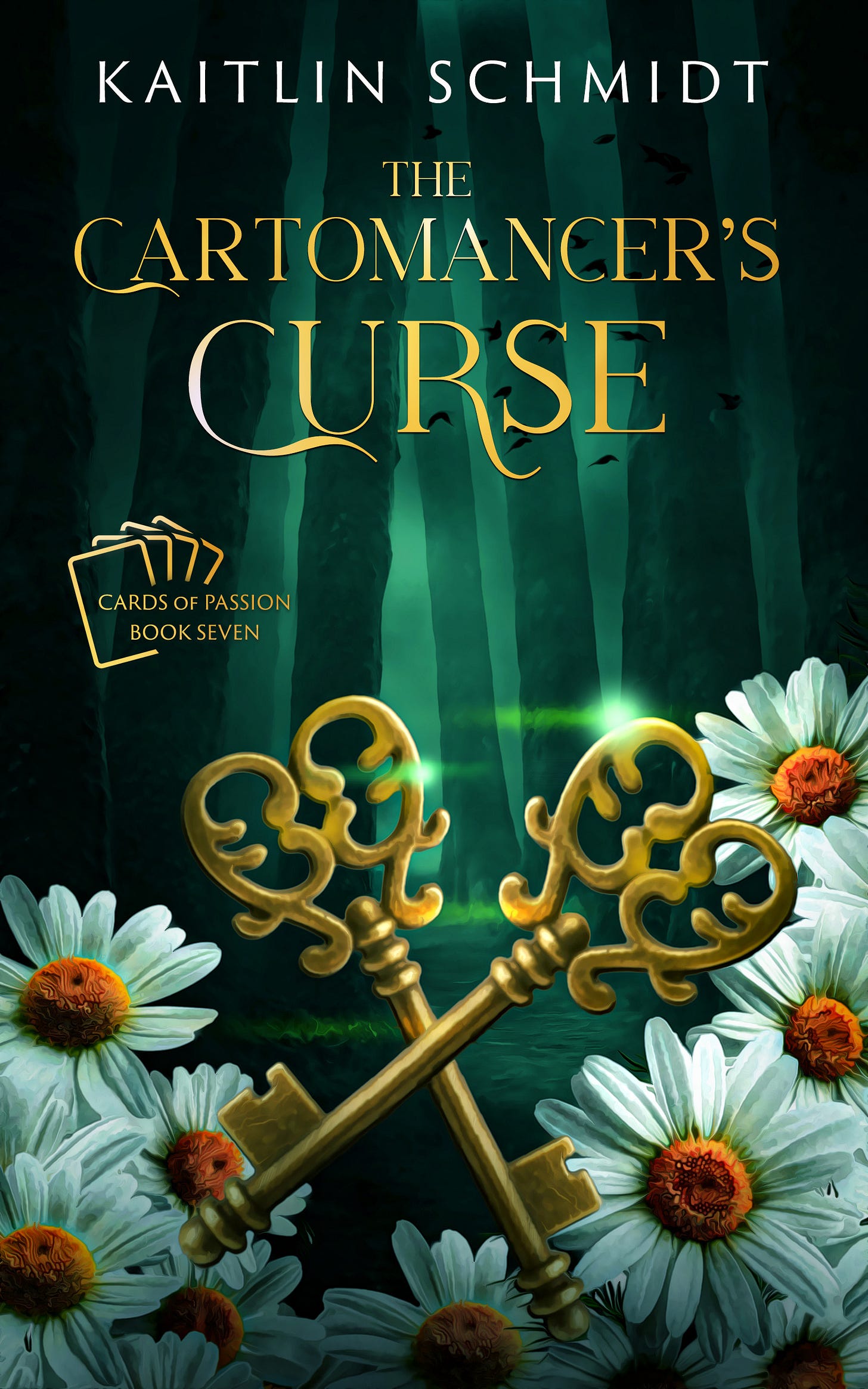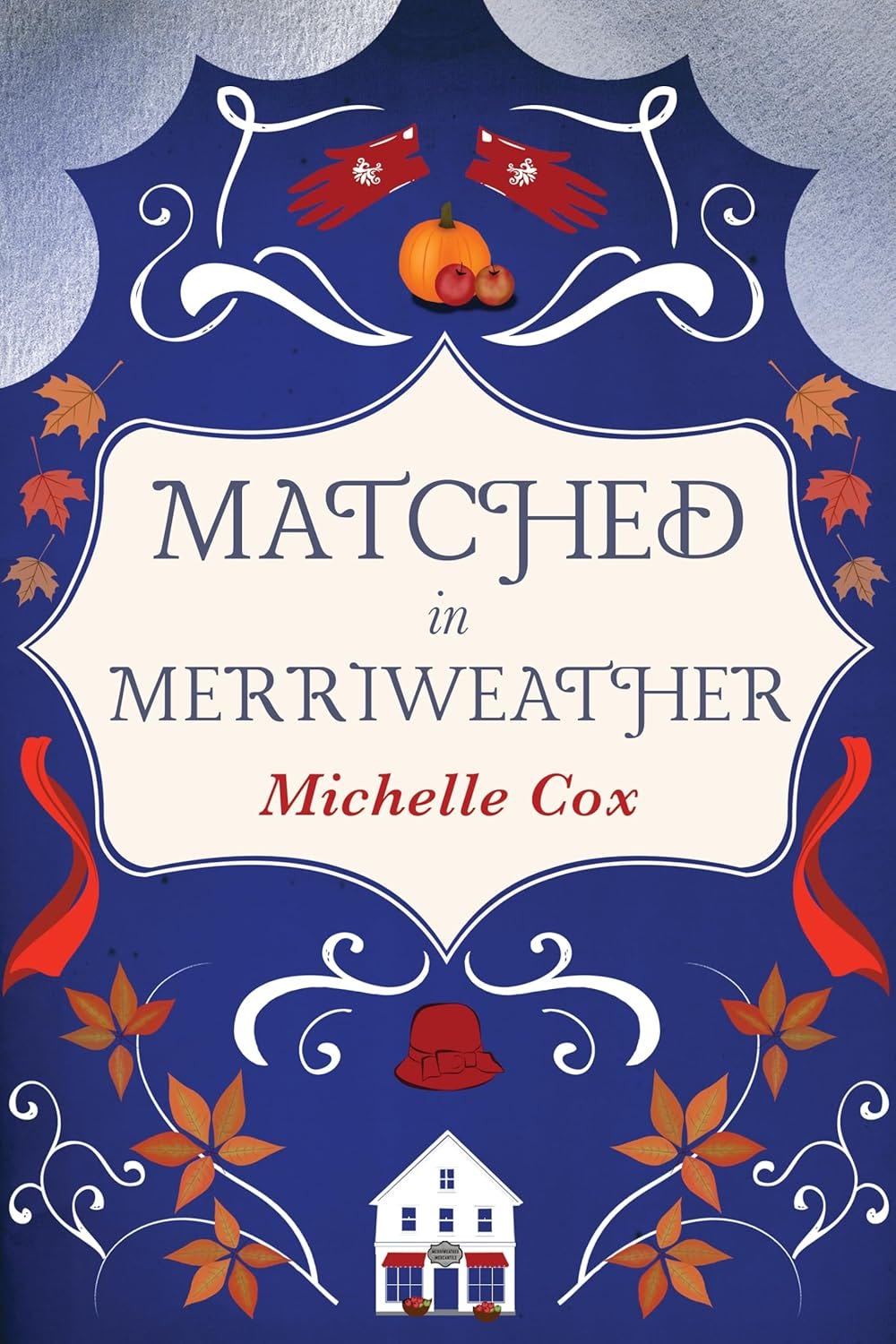Perhaps the most common conversation I have with new clients is about the different stages of editing. While many authors may be working on a budget and cannot afford every stage, it’s helpful to name and describe the stages in order to identify what the manuscript needs. This allows authors to make informed choices about which editors they hire. Today, I’ll break down the following editing stages:
Manuscript Assessment
Developmental Editing
Line Editing
Copy Editing
Proofreading (Traditional)
Proofreading (Nontraditional)
But first, some exciting news from three authors (yours truly included)!
Author News
The Cartomancer’s Curse
I am releasing a spicy enemies-to-lovers F/F romantasy, The Cartomancer’s Curse, on September 19 as part of a multi-author project called Cards of Passion, which was spearheaded by sex educator Donna Jennings. Each book is a standalone story (I’m #7) but they have fun easter eggs with details from the other books sprinkled in. I’m thrilled about this beautiful cover from the amazing designer Erin Dameron-Hill! Scroll down for the story teaser, and consider preordering!
A psychic card reader. A guilt-ridden thief. A magical mystery to unravel.
Armed with a chaotic deck of cards and the psychic ability to taste people’s desires, cartomancer Meridian Fletcher tells fortunes from a small Seattle shop. This funds her one escape: a remote cabin, safe from the overwhelming flavors of other people’s wishes. But when thieves ransack her cabin and steal her cards, her happy place in the woods is suddenly at risk—and her livelihood, too.
One of those thieves is Wren Piper, a striking lumbersnack of a woman whose guilt drives her to confess. Wren wants to make amends, but Meridian wants nothing to do with her . . . except she can’t let go of the mysterious flavor she senses from Wren: molasses. It’s a desire she’s never encountered before.
That damn molasses must mean something, and Meridian draws cards for Wren to discover what. But the reading reveals more than either woman expects, and they cut it short. Doing so saddles them with a curse, and now they’re stuck together until they break it. Yet, the more Meridian learns about Wren’s desires—and her own desire for Wren—the less she minds being stuck with her.
THE CARTOMANCER’S CURSE is a steamy enemies-to-lovers romantasy in which two women succumb to desire, explore sexual bondage, and unravel a magical mystery.
Shadows and Silhouettes
The first book in the Cards of Passion series is Shadows and Silhouettes, by Donna Jennings. I had the pleasure of copy editing this one and following the healing journey of Olivia Thornton, a young sex educator battling premenopause. If you are looking for a story that heals and educates at the same time, look no further!
Two broken bodies + one healing summit = secrets uncovered and hearts cracked open.
Olivia “Liv” Thornton
How could my assigned creativity summit partner be him, a renowned hunk of a grump landscape photographer, whom I accidentally tripped at the airport? Every day, he’d remind me why I’m here—broken, sent to confront my deepest fear—would I ever experience pleasure again? Well, that and not being a hypocrite in my sex education practice. But would Adrian hinder or help my progress? Would all my desires come alive?
Adrian Blake
The summit directors had lost their minds, placing me with a hot sex educator—and Liv would be a thorn in my side before we even started. Every day since I left the hospital, I denied what that mountain had taken from me, but Liv unknowingly reflected my secret back to me. Would I have to go through her to do the work and return to my job, passion, artistic expression, and my identity as a man?
Two broken souls. One lush paradise. Join Liv and Adrian as they navigate desire, healing, and the art of genuine emotional connection.
Shadows & Silhouettes: Cards of Passion Book One is the origin story of the Cards of Passion Series. It is a standalone slow-burn MF grumpy small-town mountain romance.
Matched in Merriweather
I recently proofread this delightful novel by Michelle Cox. It’s a genre-bending historical romance that’s somehow cozy, cute, researched, and thoughtful all at once. And the chemistry between Melody and Cal—chef’s kiss! What’s even better is that it’s a Jane Austen retelling. It releases September 5. Scroll down for the story teaser and consider preordering!
From the best-selling author of The Henrietta and Inspector Howard series comes . . .
A delightful 1930s retelling of Jane Austen’s beloved classic Emma.
After receiving a desperate letter reporting her father to be gravely ill, inveterate matchmaker Melody Merriweather leaves college and rushes back to her small hometown of Merriweather, Wisconsin—only to discover that she’s expected to take over the running of her family’s general store, the Merc, until he recovers.
There, Melody tries to liven up the dusty old shop by selling luxury hats and gloves while also managing the handful of eccentric employees she’s inherited—the sweet, impressionable Harriet; the crabby Mrs. Haufbrau; and the overly critical but irritatingly handsome Cal Frasier. In typical Melody fashion, it isn’t long before she sets her sights on helping Harriet find a more suitable match than the local farmer who supplies the Merc with eggs.
All of Melody’s fanciful ideas suddenly fly out the window, however, when she learns that the Merc is not so well off as she imagined and that her father has borrowed money from loan sharks to keep it afloat. With the help of a surly Cal, Melody concocts a plan to brew cider as a way to resurrect the failing store. But when her attempts at both cider- and matchmaking go awry in spectacular fashion, it throws the Merc—and her own self-confidence—further into jeopardy . . .
The Stages of Editing
Here’s my breakdown of the different stages of editing:
Manuscript Assessment
Also called manuscript evaluation, editorial assessment, and manuscript overview, this is a type of editing under the umbrella of developmental editing. A manuscript assessor reads the draft and gives detailed critique of the big-picture elements like plot, character, conflicts, and pacing. Feedback is delivered in the form of a lengthy edit letter rather than in-document comments and redlining.
Developmental Editing
Like a manuscript assessor, a developmental editor gives detailed critique of the big-picture elements like plot, character, conflicts, and pacing. Unlike a manuscript assessor, they will leave in-document comments and redlining in addition to delivering a lengthy edit letter. They may reorder and rethink substantial parts of your story in addition to offering critiques and suggestions. The biggest difference between this and a manuscript assessment is the amount of specificity in pointing out where the story is and isn’t working, which is why developmental editing includes in-document work.
Line Editing
Line editors perform a paragraph- and sentence-level edit with attention to craft, effectiveness, and readability. While this includes grammar, it’s not as granular as a copy edit; the goal is to shape each sentence for the sake of effective storytelling. A heavy copy edit often overlaps with line editing, which I would argue is because clarity—the copy editor’s darling—is best achieved through effective storytelling. Pure line editing, however, involves more creative and more subjective stylistic editing than copy editing. For example: If a character has done something surprising in front of a second character, but the author has failed to write in a reaction beat for the second character, a line editor would help the author flesh out the missing beat. A copy editor, on the other hand, would madly repeat “that ship has sailed” to themselves and resist the urge to comment because they’re not getting paid enough to do that.
Copy Editing (yay, my favorite!!)
Copy editors are concerned with clarity and consistency at a granular level. Above all, they perform a word-level edit with attention to grammar, punctuation, spelling, usage, and style. They conform the text to a style guide, such as The Chicago Manual of Style, and a dictionary, such as Merriam Webster’s Collegiate Dictionary. They may typecode your book, which means identifying each type of text (body text, headings, subheadings, etc.) in preparation for your book to be formatted.
Copy editors also create a style sheet specific to your project, an invaluable step that prevents inconsistencies of all kinds. This document includes not only a list of variant word spellings, but also a timeline of events, character descriptions, place descriptions, and style and formatting notes. In my experience, no matter how much love an author has given their draft, there are almost always timeline inconsistencies in addition to the more run-of-the-mill spelling, grammar, and punctuation issues.
It should be noted that there are three levels of copy editing: light, medium, and heavy. Light copy editing focuses on indisputable mechanical errors like spelling and grammar, while heavy copy editing addresses more subjective concerns like fluency, transitions, gaps in logic, and passive voice. Medium copy editing, of course, falls somewhere in between.
Proofreading (Traditional)
Traditionally, proofreading is reserved for the proof of the book (hence the name). While proofreaders do attend to grammar, punctuation, spelling, usage, and style, they also call attention to formatting errors such as rivers, ladders, and bad breaks; widows; and spacing inconsistencies. Writers submit proofs in the form of hard copies or PDFs, and proofreaders reference a style guide, dictionary, and the style sheet created by the project’s copy editor to check for internal consistency as they read.
Proofreading (Nontraditional)
Independent authors sometimes prefer to have their work proofread after the copy edit but before the formatting stage. This is purely to catch residual errors left over from the copy editor and check to make sure the style sheet has been followed consistently. They can then opt for a second round of proofreading after the book has been formatted, or review the formatted product for errors on their own.
On a Tight Budget?
If you are a new self-publishing author trying to save money on everything from editing to cover design, I get it. I was invited to self-publish a novella as part of a multi-author project called Cards of Passion, and my debut romantasy, The Cartomancer’s Curse, is coming out on September 19. I was not able to afford every level of editing. Because of financial constraints, I had to ask myself where I needed the most editorial support, and how much money I was willing to put into this product from a business perspective. A few examples of things to think through:
If you can’t afford true developmental editing, what about a manuscript assessment? At the very least, can you exchange beta reads with other skilled writers who are also working on manuscripts of roughly equal length?
Can’t afford a pure line edit? Maybe you could pay your copy editor extra for a heavy copy edit to catch some of those stylistic concerns.
Not sure what kind of edit your book would benefit from? It might be worth requesting a one-off consultation with an editor to ask them to evaluate the needs of your book and help you decide, especially because the answer might differ depending on if you’re self-publishing versus querying traditional publishers and agents. Though some editors may do this for free, be prepared to pay for their time, including the time they may spend reviewing your manuscript before the consultation itself begins.
I hope this helps you understand each stage of editing so you can make informed choices for your manuscript!
Questions?
Questions about the stages of editing? I’d be delighted to hear from you.
Looking for an Editor?
I specialize in copy editing and proofreading. I also offer and greatly enjoy substantive editing (manuscript assessments and line editing). I am primarily seeking genre fiction projects, especially fantasy, romance (🌶️ welcome!), LGBTQ+, or all three combined. I also enjoy editing memoir, literary fiction, poetry, creative nonfiction, instructional/self-help nonfiction, and professional writing. If you’re interested in working with me, click the link below and ask me for more information or a free sample edit!









Very helpful to have the details of editing expanded and spelled out in this way
Thank you so much for sharing this Kaitlin!!! It is super helpful!!!!